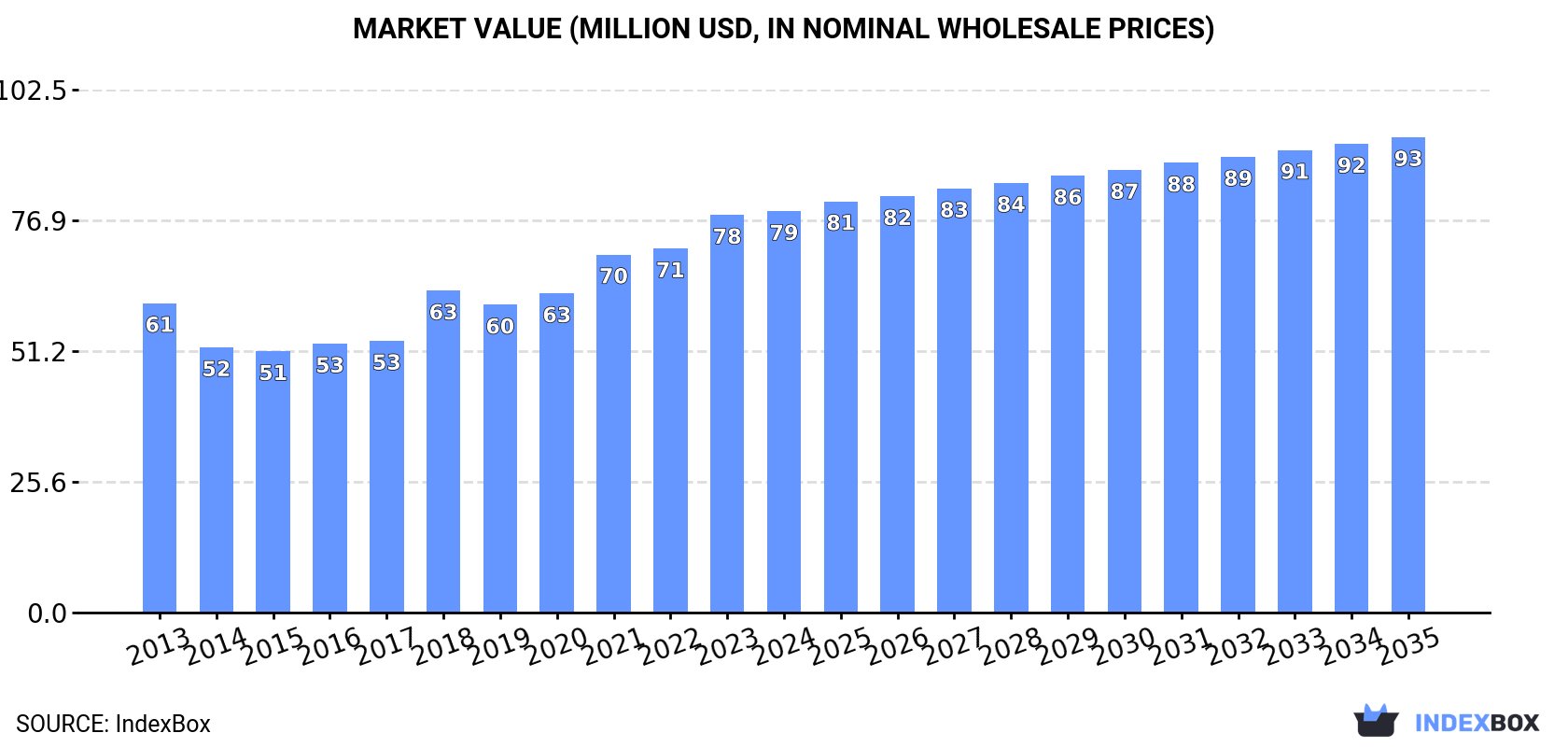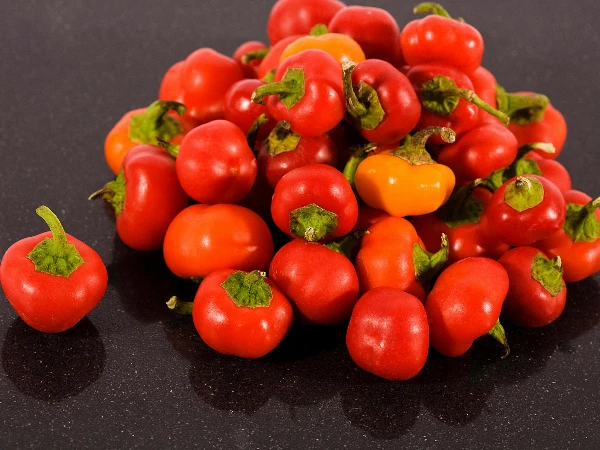Jun 15, 2025
IndexBox has just published a new report: Japan – Pimenta Pepper – Market Analysis, Forecast, Size, Trends and Insights.
The demand for pimenta pepper in Japan is on the rise, with market volume expected to reach 16K tons and market value to hit $93M by the end of 2035. Despite a slight deceleration in market performance, the anticipated CAGR of +0.1% for volume and +1.6% for value from 2024 to 2035 indicates continued growth in the industry.
Market Forecast
Driven by increasing demand for pimenta pepper in Japan, the market is expected to continue an upward consumption trend over the next decade. Market performance is forecast to decelerate, expanding with an anticipated CAGR of +0.1% for the period from 2024 to 2035, which is projected to bring the market volume to 16K tons by the end of 2035.
In value terms, the market is forecast to increase with an anticipated CAGR of +1.6% for the period from 2024 to 2035, which is projected to bring the market value to $93M (in nominal wholesale prices) by the end of 2035.
 ConsumptionJapan’s Consumption of Pimenta Pepper
ConsumptionJapan’s Consumption of Pimenta Pepper
Pimenta pepper consumption in Japan expanded slightly to 16K tons in 2024, rising by 3.1% compared with the year before. Overall, consumption showed modest growth. Pimenta pepper consumption peaked in 2024 and is expected to retain growth in the immediate term.
The revenue of the pimenta pepper market in Japan totaled $79M in 2024, approximately mirroring the previous year. This figure reflects the total revenues of producers and importers (excluding logistics costs, retail marketing costs, and retailers’ margins, which will be included in the final consumer price). The market value increased at an average annual rate of +2.4% over the period from 2013 to 2024; the trend pattern indicated some noticeable fluctuations being recorded throughout the analyzed period. Over the period under review, the market attained the maximum level in 2024 and is expected to retain growth in the immediate term.
ImportsJapan’s Imports of Pimenta Pepper
In 2024, the amount of pimenta pepper imported into Japan rose to 16K tons, surging by 3.1% against the previous year. Over the period under review, imports showed a mild expansion. The growth pace was the most rapid in 2018 when imports increased by 20%. Over the period under review, imports attained the maximum in 2024 and are likely to continue growth in years to come.
In value terms, pimenta pepper imports amounted to $81M in 2024. In general, total imports indicated tangible growth from 2013 to 2024: its value increased at an average annual rate of +2.6% over the last eleven years. The trend pattern, however, indicated some noticeable fluctuations being recorded throughout the analyzed period. Based on 2024 figures, imports increased by +57.8% against 2015 indices. The growth pace was the most rapid in 2018 when imports increased by 18%. Imports peaked in 2024 and are likely to see gradual growth in the near future.
Imports By Country
In 2024, China (13K tons) constituted the largest supplier of pimenta pepper to Japan, with a 86% share of total imports. Moreover, pimenta pepper imports from China exceeded the figures recorded by the second-largest supplier, Spain (731 tons), more than tenfold. The third position in this ranking was held by South Korea (515 tons), with a 3.3% share.
From 2013 to 2024, the average annual growth rate of volume from China was relatively modest. The remaining supplying countries recorded the following average annual rates of imports growth: Spain (-1.1% per year) and South Korea (+1.9% per year).
In value terms, China ($65M) constituted the largest supplier of pimenta pepper to Japan, comprising 80% of total imports. The second position in the ranking was taken by South Korea ($3.9M), with a 4.9% share of total imports. It was followed by Spain, with a 4.5% share.
From 2013 to 2024, the average annual growth rate of value from China totaled +3.1%. The remaining supplying countries recorded the following average annual rates of imports growth: South Korea (+1.8% per year) and Spain (-0.8% per year).
Import Prices By Country
The average pimenta pepper import price stood at $5,168 per ton in 2024, declining by -2.4% against the previous year. Over the last eleven-year period, it increased at an average annual rate of +1.7%. The pace of growth appeared the most rapid in 2022 an increase of 7.1% against the previous year. Over the period under review, average import prices reached the peak figure at $5,293 per ton in 2023, and then declined slightly in the following year.
There were significant differences in the average prices amongst the major supplying countries. In 2024, amid the top importers, the country with the highest price was South Korea ($7,666 per ton), while the price for China ($4,849 per ton) was amongst the lowest.
From 2013 to 2024, the most notable rate of growth in terms of prices was attained by China (+2.1%), while the prices for the other major suppliers experienced more modest paces of growth.
ExportsJapan’s Exports of Pimenta Pepper
In 2024, approx. 111 tons of pimenta pepper were exported from Japan; with an increase of 2.5% on 2023 figures. In general, exports recorded a relatively flat trend pattern. The pace of growth was the most pronounced in 2019 with an increase of 68%. As a result, the exports attained the peak of 133 tons. From 2020 to 2024, the growth of the exports remained at a lower figure.
In value terms, pimenta pepper exports expanded significantly to $1.6M in 2024. Overall, total exports indicated a tangible increase from 2013 to 2024: its value increased at an average annual rate of +2.2% over the last eleven-year period. The trend pattern, however, indicated some noticeable fluctuations being recorded throughout the analyzed period. Based on 2024 figures, exports decreased by -1.8% against 2021 indices. The pace of growth was the most pronounced in 2021 with an increase of 47% against the previous year. As a result, the exports reached the peak of $1.6M; afterwards, it flattened through to 2024.
Exports By Country
The United States (36 tons) was the main destination for pimenta pepper exports from Japan, with a 33% share of total exports. Moreover, pimenta pepper exports to the United States exceeded the volume sent to the second major destination, the Philippines (14 tons), threefold. Indonesia (12 tons) ranked third in terms of total exports with an 11% share.
From 2013 to 2024, the average annual rate of growth in terms of volume to the United States totaled +5.7%. Exports to the other major destinations recorded the following average annual rates of exports growth: the Philippines (+29.5% per year) and Indonesia (+12.3% per year).
In value terms, the United States ($650K) remains the key foreign market for pimenta pepper exports from Japan, comprising 41% of total exports. The second position in the ranking was taken by the Philippines ($112K), with a 7.1% share of total exports. It was followed by Singapore, with a 6.1% share.
From 2013 to 2024, the average annual growth rate of value to the United States stood at +9.1%. Exports to the other major destinations recorded the following average annual rates of exports growth: the Philippines (+20.8% per year) and Singapore (+24.5% per year).
Export Prices By Country
In 2024, the average pimenta pepper export price amounted to $14,248 per ton, increasing by 3% against the previous year. Over the period from 2013 to 2024, it increased at an average annual rate of +1.9%. The growth pace was the most rapid in 2020 an increase of 35% against the previous year. Over the period under review, the average export prices reached the maximum at $15,498 per ton in 2021; however, from 2022 to 2024, the export prices remained at a lower figure.
There were significant differences in the average prices for the major foreign markets. In 2024, amid the top suppliers, the country with the highest price was Taiwan (Chinese) ($33,040 per ton), while the average price for exports to Indonesia ($6,813 per ton) was amongst the lowest.
From 2013 to 2024, the most notable rate of growth in terms of prices was recorded for supplies to Taiwan (Chinese) (+12.6%), while the prices for the other major destinations experienced more modest paces of growth.
Source: IndexBox Market Intelligence Platform
